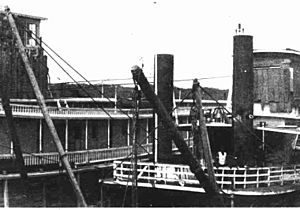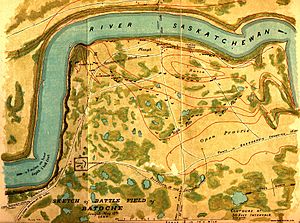Battle of Batoche facts for kids
Quick facts for kids Battle of Batoche |
|||||||
|---|---|---|---|---|---|---|---|
| Part of the North-West Rebellion | |||||||
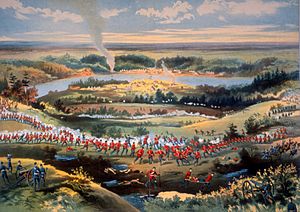 A drawing of the Battle of Batoche from that time |
|||||||
|
|||||||
| Belligerents | |||||||
| Provisional Government of Saskatchewan (Métis) | |||||||
| Commanders and leaders | |||||||
| Gabriel Dumont Louis Riel |
Frederick Middleton Bowen van Straubenzee |
||||||
| Strength | |||||||
| 250 (Métis) | 916 regulars and militia | ||||||
| Casualties and losses | |||||||
| 16 dead 30 wounded |
8 dead 46 wounded |
||||||
The Battle of Batoche was a very important battle during the North-West Rebellion. This conflict was between the Canadian government and a group of First Nations and Métis people. The battle happened from May 9 to 12, 1885, in Batoche, Saskatchewan. This town was the temporary capital for the Provisional Government of Saskatchewan. General Frederick Dobson Middleton's forces had more soldiers and better weapons. They eventually defeated the Métis fighters.
After the defenders of Batoche were defeated and the town was captured, Louis Riel gave up on May 15. This also led to the end of the Provisional Government. Other groups involved in the rebellion were chased and eventually stopped fighting. Poundmaker surrendered on May 26. Cree fighters and families led by Big Bear fought for the longest time. They managed to fight off Canadian troops in the Battle of Frenchman's Butte and Battle of Loon Lake. Their numbers slowly decreased as they hid in the wilderness. Big Bear finally gave himself up to the North-West Mounted Police at Fort Carlton in early July.
Contents
The Fight Begins: The Northcote Incident
General Middleton was careful as he approached Batoche. He knew that government forces had faced difficulties in earlier battles like Duck Lake, Fish Creek, and Cut Knife. Middleton reached Gabriel's Crossing on May 7. The next day, he was about 13 kilometers from Batoche.
Middleton's plan was to surround the town. His main group would attack the Métis defenses from the front. At the same time, a steamboat called the Northcote would sneak past the defenders. It would then drop off fifty soldiers at the back of the town. This would trap the Métis fighters.
However, the land was difficult, and Middleton moved slowly. This meant his forces were behind schedule. When the Northcote arrived near the town on May 9, the Métis saw it. They had not yet been attacked by artillery. Their small guns did not hurt the armored ship much. But they lowered Batoche's ferry cable. The Northcote sailed right into it without knowing. The cable ripped off its masts and smokestacks. The damaged ship then floated down the South Saskatchewan River and out of the battle.
The Battle of Batoche
First Day: Mission Ridge (May 9)
Middleton did not know what had happened to the Northcote. On the morning of May 9, he moved towards the church at Mission Ridge. He wanted to start his attack plan. Some Métis in two houses south of the church began shooting at Canadian cavalry called Boulton's Scouts. Artillery was used to shell the houses, and one caught fire. The Métis fighters ran towards the settlement. The troops then moved towards the church.
As they got closer to the church and a nearby house, they saw people. They thought these people were the enemy. Second Lieutenant Arthur L. Howard fired his Gatling gun at the house. Then, a white flag was raised, and Howard stopped firing. Several priests, nuns, women, and children came out. Middleton realized only civilians were there. He then brought his artillery onto the ridge and began shelling the town.

The soldiers moved past the church. They went about half a kilometer before they faced heavy gunfire from both sides of the trail. The soldiers quickly took cover. Their enemies were hidden in strong rifle pits and could not be seen. One soldier later wrote that they were "firing at nothing" while bullets flew all around them.
The Canadian cavalry, Boulton's and French's Scouts, were now on foot. They were placed on the right side. The 10th Royal Grenadiers, infantry from Toronto, were in the middle. The 90th Winnipeg Rifles and Howard with his Gatling gun were on the left. They protected the artillery. The infantry of the Midland Battalion from eastern Ontario were kept in reserve near the church. The church was now being used as a Canadian field hospital.
A dangerous moment happened when a group of Métis rushed towards the artillery. Only Howard's heavy Gatling gun fire stopped them. This was one of the few times the soldiers clearly saw the Métis fighters.
After this attack was stopped, the artillery was moved back a few hundred meters. The infantry and Scouts followed. The Métis then moved their fighters to try and surround the Canadian soldiers. Heavy fighting continued. After noon, the artillery was ordered forward again. It began firing at the hidden Métis rifle pits, but it didn't do much. The gunners were under heavy fire and in a very unsafe spot. The Midlanders wanted to charge their unseen enemies, but Middleton told them not to.
The Gatling gun was very useful throughout the day. It provided cover fire when cannons had to be moved back from sniper fire. It also stopped another attempt by Gabriel Dumont to capture the guns.
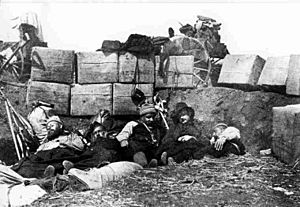
Canadian advances were slow but careful, keeping their losses low. The Métis tried to surround the Canadian lines. They used brushfires to hide their movement, but the fires did not spread. So, their plan failed. By the end of the day, both sides held their positions at Mission Ridge. Middleton was shaken by the strong resistance. He ordered the Canadian soldiers to go back to a "zareba." This was a quickly built fort about a mile from the Métis defenses. The troops slept there behind their temporary walls.
Testing the Defenses (May 10 to May 11)
On May 10, Middleton set up well-protected gun positions. He then shelled the town all day long, causing much damage. However, any attempts to advance were stopped by Métis gunfire. No ground was gained that day.
The next day, Middleton tried to figure out how strong the defenders were. He sent a group of men north along the enemy's side. At the same time, he started a general advance along the front. The Métis had to move some of their fighters to hold the northern side. This meant they did not have enough people to stop the Canadian push. They gave up ground with little resistance. Canadian soldiers went as far as the Batoche cemetery before turning back. Middleton was happy with how weak his enemies seemed. He decided to rest and planned to take the town the next morning.
Taking Batoche (May 12)
By May 12, the Métis defenses were in bad shape. Three-quarters of the original defenders were either hurt by artillery fire or spread out from fighting. Those who still held their positions were tired and had very little ammunition. They even searched for bullets fired by government troops to shoot them back. Some fired nails, rocks, forks, and knives instead of bullets from their rifles.
Middleton's attack plan for this day was similar to the day before. One group would draw defenders away to the north. A second group, led by Colonel Bowen van Straubenzee, would attack the town directly. At first, on the morning of May 12, Middleton's plan went wrong. Van Straubenzee and his men did not attack. The wind was blowing away from them, so they did not hear the gunfire from the northern group. Middleton, who was with the northern group, returned to camp very angry. He shouted at van Straubenzee and the Canadian colonels, then left for lunch.
The night before, some senior Canadian officers were frustrated by Middleton's caution. They had talked about making a charge. Now, van Straubenzee was more open to this idea. After noon, the Midlanders and Royal Grenadiers moved forward again. They reached a spot near the Batoche Cemetery. No one knows exactly who ordered the wild charge that happened next. Firing their guns and cheering, the Midlanders and Grenadiers, helped by the Winnipeg 90th Rifles, rushed at the Métis rifle pits.
Many Métis fighters were still out of position. They had been drawn away to the north-east by Middleton's trick that morning. Ammunition for the Métis was very low. Still, they fought bravely. Sharpshooters from across the Saskatchewan River helped them by firing at the charging soldiers.
However, the charge was too strong to stop. Middleton ordered the rest of the troops to help by covering the sides of the charging men. Howard and his Gatling gun were moved up. The charging soldiers stormed into the village of Batoche. Then, their enemies regrouped. Métis and First Nations who had been drawn away by Middleton's trick now appeared. They started heavy fire from rifle pits near the village. A senior Canadian officer, Captain French, was killed. But the artillery and the Gatling gun were brought up to break this new resistance. The last defenders of Batoche gave up.
Straubenzee's soldiers charged into Batoche. They drove the remaining Métis out of the town. Middleton's plan, combined with a sudden charge by Canadian soldiers, led to the defeat of the last defenders. The fighting at Batoche ended.
After the Battle
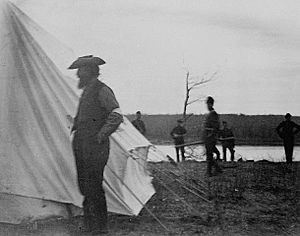
The Métis defeat at Batoche mostly ended the North-West Rebellion.
Louis Riel was captured. He later faced severe consequences for his role in the rebellion.
Gabriel Dumont escaped to the United States. He returned to Batoche in 1893. When he passed away, he was buried there.
Poundmaker and Big Bear were both sent to prison.
Most regular fighters were given a pardon. However, some murders that happened outside of the fighting were punished. The largest mass hanging in Canadian history took place in November 1885. Eight men lost their lives.
Middleton's forces then went north to Prince Albert, Saskatchewan. Some parts of his army were sent home quickly to Eastern Canada.
Who Was Hurt?
Middleton reported that 8 Canadian soldiers died and 46 were wounded. He reported 51 deaths and 173 wounded on the Métis side. Later, Father Vegreville said the Métis losses were not as high. He reported 16 Métis killed and between 20 and 30 wounded. Nine of the Métis killed in the battle were buried in the Batoche cemetery. Eight of them were in a shared grave.
The Bell of Batoche
After the battle, it is said that some Canadian soldiers from Millbrook, Ontario, took the bell from the Batoche church. They took it back to Ontario as a prize. What happened to the bell became a long-standing argument. Several Métis groups and the governments of Ontario, Manitoba, and Saskatchewan were involved. The Millbrook bell is now believed to be the same as the Bell of Frog Lake.
What We Remember Today
In the spring of 2008, Christine Tell, a government minister, said that the 125th anniversary of the 1885 Northwest Resistance in 2010 was a great chance. It was an opportunity "to tell the story of the prairie Métis and First Nations peoples' struggle with Government forces and how it has shaped Canada today."
Batoche, where the Métis Provisional Government was formed, is now a national historic site. At Batoche, you can find Gabriel Dumont's grave, Albert Caron's House, the Batoche school, the Batoche cemetery, the Letendre store, Gabriel's river crossing, Gardepy's crossing, Batoche crossing, St. Antoine de Padoue Church, Métis rifle pits, and the Canadian army's battle camp.


